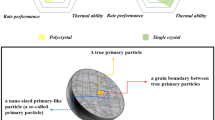Abstract
Lithium nickel manganate is recognized as a type of promising cathode material for lithium-ion battery, due to its advantages such as high voltage, high power density, and relative lower cost. In this paper, a series of LiNi x Mn2 − x O4 cathode materials with various molar ratio of Ni/Mn have been prepared with a co-precipitation method, followed by a solid state reaction, and the effect of the molar ratio of Ni/Mn on the structure and properties of materials are intensively investigated by means of X-ray diffraction (XRD), Fourier transform infrared spectrometer (FTIR), scanning electron microscopy (SEM), and performance measurements, etc. It is revealed that all the samples with x from 0 to 0.5 have well-defined spinel structure and fit well to Fd-3 m space group. With the increase of the molar ratio of Ni/Mn, the diffraction peaks shift to higher angle slightly and the lattice parameter decreases gradually by the XRD results. Furthermore, it is found that the capacity at the 4.0 V plateau decreases while the capacity at 4.7 V plateau increases with the increase of the ratio of Ni/Mn, and the total discharge capacity shows growth trend with the increase of Ni content. It is important that all the samples with various molar ratio of Ni/Mn exhibit good cyclic stability. Based on the experimental results, we suggest that the Ni may incorporate into the lattice of LiMn2O4 substituting of Mn. The plateau at 4.7 V is related to the Ni ions and the plateau at 4.0 V is related to the Mn ions in the materials.





Similar content being viewed by others
References
Santhanam R, Rambabu B (2010) J Power Sources 195:5442–5451
Zhu Z, Yan H, Zhang D, Li W, Lu Q (2013) J Power Sources 224:13–19
Li D, Ito A, Kobayakawa K, Noguchi H, Sato Y (2006) J Power Sources 161:1241–1246
Zhu Z, Zhang D, Yan H, Li W, Qilu (2013) J Mater Chem A 1:5492–5496
Fu L, Liu H, Li C, Wu Y, Rahm E, Holze R, Wu H (2005) Prog Mater Sci 50:881–928
Chemelewski KR, Lee ES, Li W, Manthiram A (2013) Chem Mater 25:2890–2897
Ivanova S, Zhecheva E, Stoyanova R, Nihtianova D, Wegner S, Tzvetkova P, Simova S (2011) J Phys Chem C 115:25170–25182
Lee ES, Manthiram A (2013) J Mater Chem A 1:3118–3126
Liu J, Sun Z, Xie J, Chen H, Wu N, Wu B (2013) J Power Sources 240:95–100
Yi CW, Shi JY, Kim K (2011) Abstr Pap Am Chem Soc 241:1155
Zhao G, Lin Y, Zhou T, Lin Y, Huang Y, Huang Z (2012) J Power Sources 215:63–68
Huang YY, Zeng XL, Zhou C, Wu P, Tong DG (2013) J Mater Sci 48:625–635
Qian Y, Deng Y, Shi Z, Zhou Y, Zhuang Q, Chen G (2013) Electrochem Commun 27:92–95
Cao A, Manthiram A (2012) Phys Chem Chem Phys 14:6724–6728
Zhong QM, Bonakdarpour A, Zhang MJ, Gao Y, Dahn JR (1997) J Electrochem Soc 144:205–213
Kunduraci M, Amatucci GG (2007) J Power Sources 165:359–367
Wei YJ, Kim KB, Chen G (2006) Electrochim Acta 51:3365–3373
Wu HM, Tu JP, Chen XT, Li Y, Zhao X, Cao GS (2007) J Solid State Electrochem 11:173–176
Gu X, Li XW, Xu LQ, Xu HY, Yang J, Qian YT (2012) Int J Electrochem Sci 7:2504–2512
Liu ZS, Jiang YM, Zeng XY, Xiao G, Song HY, Liao SJ (2014) J Power Sources 247:437–443
Wei Y, Nam K, Kim K, Chen G (2006) Solid State Ionics 177:29–35
Nakamura T, Yamada Y, Tabuchi M (2005) J Appl Phys 98:093905
Xu Y, Chen G, Fu E, Zhou M, Dunwell M, Fei L, Deng S, Andersen P, Wang Y, Jia Q, Luo H (2013) RSC Adv 3:18441–18445
Gu X, Xu LQ, Xu HY, Yang J, Qian YT (2012) Int J Electrochem Sci 7:2504–2512
Shin DW, Bridges CA, Huq A, Paranthaman MP, Manthiram A (2012) Chem Mater 24:3720–3731
Kunduraci M, Al-Sharaband JF, Amatucci GG (2006) Chem Mater 18:3585–3592
Wang L, Li H, Huang X, Baudrin E (2011) Solid State Ionics 193:32–38
Lee ES, Nam KW, Hu E, Manthiram A (2012) Chem Mater 24:3610–3620
Wen SJ, Richardson TJ, Ma L, Striebel KA, Ross PN Jr, Cairns EJ (1996) J Electrochem Soc 143:136–138
Wu YP, Rahm E, Holze R (2002) Electrochim Acta 47:3491–3507
Acknowledgments
This work was supported by the National Science Foundation of China (NSFC Project Nos. 21076089, 21276098, 11132004, U1301245), Guangdong Natural Science Foundation (Project No S2012020011061), Doctoral Fund of Ministry of Education of China (20110172110012), and Doctoral Fund of Department of Education of Guangdong.
Author information
Authors and Affiliations
Corresponding author
Rights and permissions
About this article
Cite this article
Ren, W., Luo, R., Liu, Zs. et al. Effect of Ni/Mn ratio on the performance of LiNi x Mn2 − x O4 cathode material for lithium-ion battery. Ionics 20, 1361–1366 (2014). https://doi.org/10.1007/s11581-014-1114-3
Received:
Revised:
Accepted:
Published:
Issue Date:
DOI: https://doi.org/10.1007/s11581-014-1114-3




